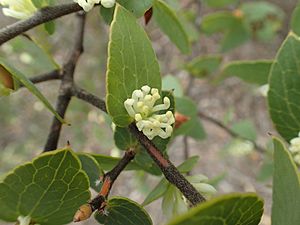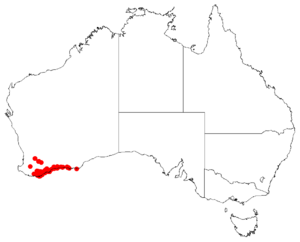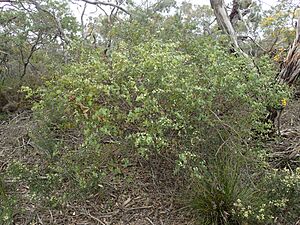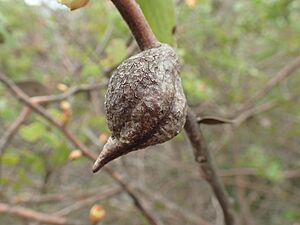Rusty hakea facts for kids
Quick facts for kids Rusty hakea |
|
|---|---|
 |
|
| Hakea ferruginea growing near the Stirling Range National Park | |
| Scientific classification | |
| Genus: |
Hakea
|
| Species: |
ferruginea
|
 |
|
| Where Hakea ferruginea is found in Australia | |
Hakea ferruginea, also known as rusty hakea, is a type of bush that belongs to the Proteaceae plant family. It has flat leaves and beautiful white to cream-coloured flowers. These flowers bloom from late winter to mid-summer. This plant is special because it grows only in Western Australia.
What is Rusty Hakea?
Rusty hakea is a straight, rounded bush that usually grows to be about 1 to 4.5 meters (3 to 15 feet) tall. Its small branches are a bit fuzzy. The leaves grow one after another along the stem. These pale green leaves are flat and can be shaped like a narrow egg or an oval. They are typically 1.5 to 8.5 centimeters (0.6 to 3.3 inches) long and 1.2 to 2.7 centimeters (0.5 to 1.1 inches) wide.
The plant blooms from July to November, showing off its white or cream-coloured flowers. Each group of flowers has 16 to 20 blooms with creamy-white petals. After the flowers, the plant grows fruit that looks like a slanted egg with a small beak. These fruits are about 2 to 3.1 centimeters (0.8 to 1.2 inches) long. Inside, the black or brown seeds are narrow and oval, with a wing on one side that helps them fly away.
Naming the Plant
The rusty hakea was first officially named by a scientist named Robert Sweet in 1827. He wrote about it in a book called Flora Australasica. Another name for it, which is no longer used, was Hakea repanda.
The second part of its scientific name, ferruginea, comes from a Latin word meaning "rust-coloured" or "rusty". This is because the new leaves of the plant often look a bit rusty-coloured.
Where it Grows
Rusty hakea is found in a few specific areas in Western Australia. You can see it in parts of the Wheatbelt region and along the southern coast in the Great Southern and Goldfields-Esperance regions. It likes to grow in sandy, rocky, or clay soils. This bush often grows in areas with mallee heath (a type of shrubland) or open forests.
How We Protect It
The Western Australian Government's Department of Parks and Wildlife says that Hakea ferruginea is "not threatened." This means it is not currently in danger of disappearing.



